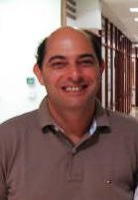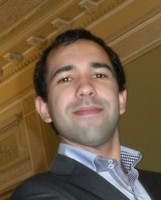Jose Matias Lopes (PI)




The XENON Dark Matter Direct Search Experiment aims to directly detect the fraction of dark matter in the Universe. The particles sustaining the existence of dark matter are known as WIMPs (Weakly Interactive Massive Particles). The existing models predict interaction rates with regular matter that can be as low as 1 event/ton Xe/year. This way large detection volumes are needed and extreme care is needed with the background radiation levels. A double phase, liquid and gas, xenon detector is proposed to detect WIMP. The XENON detection principle is based in the detection of primary scintillation (liquid phase) and secondary scintillation (gas phase) induced by the energy deposited by a WIMP interaction in xenon. XENON10 was the first detector developed for WIMP detection, starting its operation in 2006. The results obtained settled new exclusions limits in the WIMP-nucleon cross section for spin-independent interaction (Phys. Rev. Lett. 100 (2008) 21303). Since 2008, XENON100, a detector with a 10 fold larger target mass, is acquiring data. With active xenon shielding contributing to a drastically reduced radioactive background activity level plus an increased scintillation efficiency detection, XENON100 consistently delivered the best exclusion limits in dark matter search (Phys. Rev. Lett. 107 (2011) 131302; Phys. Rev. Lett., 109 (2012) 181301; Phys. Rev. Lett., 111 (2013) 021301), and attained its projected sensitivity in 2012. In 2013 a new phase started with the construction of XENON1T, a 20 fold larger target mass detector than XENON100. With an additional two hundred fold reduction on the background levels XENON1T. It started taking data in 2016 and the WIMP sensitivity limit (two orders of magnitude below the one set by XENON100) was reached after 2 years of operation, keeping the world lead in the dark matter search efforts. XENONnT construction started in 2018 and is currently acquiring science data. This final step of the program with an over 8 tons ultrapure xenon target will lead the way with the best prospects ever for dark matter detection. Real-time news on the XENONnT progress can be followed in xenonnt.org
July 10, 2024 First measurement of a nuclear recoil signal from solar neutrinos with XENONnT Alongside hypothetical dark matter particles, neutrinos from the sun have long been predicted to be observable in detectors built to search for dark matter nuclear recoil signals when these detectors reach sufficient “exposure” and “sensitivity”. Exposure means how long we waited and how much material we have used to observe particles. Sensitivity is about how good we are at detecting the tiniest particles. Observing this feeble signal, with energies barely detectable in liquid xenon time projection chambers like XENONnT, requires excellent detector performance and sophisticated signal-to-background discrimination methods. The measurement confirms the understanding of the lowest-energy signals in XENONnT. XENONnT is a direct dark matter search experiment located deep underground at the INFN Laboratori Nazionali del Gran Sasso (LNGS) in Italy. Representing one of the most advanced underground research facilities worldwide for particle physics and astrophysics, LNGS provides a unique environment that significantly reduces cosmic radiation. Operating the family of ever more sensitive experiments of the XENON program at LNGS has been critical for the success of the program. Designed to be sensitive to rare interactions of potential dark matter candidates, XENONnT’s central detector is a dual-phase time projection chamber (TPC) with 5.9 tonnes of ultra-pure liquid xenon as active target. To achieve cutting-edge performance, the XENONnT experiment employs several advanced subsystems, such as cryogenic plants to maintain the liquid xenon at the necessary low temperature, an online cryogenic distillation column for the active removal of radioactive elements diluted in the xenon, and advanced slow control and data acquisition systems. A 700 tonnes water tank featuring active Cherenkov neutron and muon veto systems surrounds the XENONnT TPC to further reduce the background. Neutrinos from the Sun can interact with the nuclei of the xenon atoms in the XENONnT target via coherent elastic neutrino-nucleus scattering (CEvNS). This Standard Model process, first predicted in 1974, has been challenging to observe due to the very low energy recoils involved and the elusive nature of neutrinos. Only in 2017, the COHERENT experiment reported the first observations of CEvNS with higher energy neutrinos from the Spallation Neutron Source in Oak Ridge, Tennessee. Now, XENONnT is the first experiment to measure CEvNS from neutrinos produced in the core of the sun, and to measure the CEvNS process with the element xenon. XENONnT thus joins the list of famous solar neutrino experiments, which typically require 10-500 times larger detector masses. XENONnT's low-energy detection capabilities and ultra-low background environment have enabled this first measurement. The analysis used data collected over two years, from July 7, 2021, to August 8, 2023, for a total exposure of approximately 3.5 tonne-years. An excess of low-energy nuclear recoil events over the expected background was measured, compatible with a signal from solar boron-8 neutrino interactions, with a statistical significance of 2.7 sigma, meaning that there is about a 0.35% chance that the observed signal is due to background noise. The result was obtained through a blinded analysis, meaning that the signal region remained obscured from the view of the scientists until all analysis steps were fixed to avoid human bias. This marks the first measurement of CEvNS from an astrophysical neutrino source. Moreover, such a significant result opens a new chapter in the direct dark matter detection field: XENONnT started exploring the so-called neutrino fog, where neutrino interactions are becoming a background that can mimic dark matter signals. As XENONnT continues to gather more data, the collaboration is looking forward to exciting discoveries in the realm of astroparticle and nuclear physics. For more details on the XENONnT experiment, please visit the XENON official website or contact the collaboration directly.
Current Coimbra XENON team:



Former Coimbra XENON team:











Institutes involved in the XENON Project:
Physics Department of the University of Coimbra 3004-516 Coimbra Portugal Phone Number: (+351) 239410667
There are currently both Ph.D. and Postdoc positions available. For information and application please contact Prof. Jose Matias-Lopes (fcjam (at) gian.fis.uc.pt).
2007:
The 6 most important Experiments in the World 2007-11-14, Discover Magazine Link
Researchers use high-tech machines to detect mysterious dark matter 2007-08-12, Associated Press article, published in USA Today and Washington Post (AP) Link
Liquid Xenon Detector Joins the Run for Dark Matter 2007-08-01, Physics Today, pp.16-18
Dark matter looks to be particularly wimpy 2007-04-17, Nature Link
2010:
Portugueses em Destaque Correio da Manhã, 29/09/2010, pág. 20, “Portugueses em destaque”
Investigadores da UC em busca da matéria negra do universo Diário de Coimbra, 29/09/2010, pág. 3
Experiência XENON100: Próximo da Matéria Negra Link
Physics World reveals its top 10 breakthroughs for 2010 2010-12-20, New Scientist Link
Dark matter stays dark 2010-05-14, Nature Link
Early Results from Large Dark Matter Detector Cast Doubt on Earlier Claims 2010-05-05, Scientific American Link
Dark Matter Claims Thrown Into Doubt by New Data 2010-05-03, New Scientist Link
Particle Detector Shows Promise, if Nothing Else 2010-05-03, The New York Times Link
2011:
Eureka - A um passo da matéria negra Link
Caça à matéria negra Visão, 21-04-2011, 94
Cientistas de Coimbra estão na corrida pelo Nobel da Física Link
Investigadores da FCTUC a um passo da matéria negra Diário As Beiras, 19-04-2011, 11
José Matias – Identificação da matéria negra Correio da Manhã, 19-04-2011, 20
Cientistas mais perto da matéria negra Diário de Coimbra, 19-04-2011, 10
Matéria negra: detecção mais perto que nunca Jornal i, 19-04-2011, 38
Portugueses querem ver matéria negra do universo Diário de Noticias, 19-04-2011, 32
A um passo da matéria negra Diário Económico, 19-04-2011, 7
A "um passo" da descoberta da matéria negra: experiência XENON100 apresenta os melhores resultados de sempre Link
Programa Portugal em Directo Programa Portugal em Directo, Antena 1, 18-04-2011
Ciência: Cientistas da Universidade de Coimbra integram equipa internacional que “persegue” descoberta da matéria negra Link
A «um passo» da descoberta da matéria negra: experiência XENON100 apresenta os melhores resultados de sempre Link
Coimbra na rota do Nobel 2011-03-17 Coimbra na rota do Nobel, Cnoticias, (2011) 38
2012:
Universidade de Coimbra ajuda a pesquisar matéria negra Diário de Coimbra, 05/08/2012, pág. 5
XENON com resultado histórico na pesquisa da matéria negra Diário das Beiras, 03/08/2012, pág. 24
Investigadores mais perto de descobrir a matéria negra Diário das Beiras, 01/08/2012, pág. 6
2013:
Enlightening the dark (Sep 27, 2013) Link
2015:
Investigadores de Coimbra participam em descoberta sobre matéria escura (21-08-2015) Link
Portugal: Experiência XENON destaca-se na procura da matéria escura (22-08-2015) Link
Investigadores da Universidade de Coimbra publicam na revista Science (24-08-2015) Link
2 Steps Closer to the Search for Dark Matter and Dark Energy (21-08-2015) Link
Projeto criado num dos maiores laboratórios subterrâneos procura matéria escura (11-11-2015) Link
Matéria escura pode ser descoberta nos próximos dois anos (11-11-2015) Link
Equipamento inédito para detetar matéria negra é inaugurado hoje em Itália (11-11-2015) Link
Equipamento inédito para detetar matéria negra é inaugurado hoje em Itália (11-11-2015) Link
Equipamento inédito para detetar matéria negra é inaugurado hoje em Itália (11-11-2015) Link
Equipamento inédito para detetar matéria negra é inaugurado hoje em Itália (11-11-2015) Link
Equipa internacional inaugura o XENON1T e dá um passo de gigante na procura de matéria escura (11-11-2015) Link
Equipamento inédito para detetar matéria escura é inaugurado hoje em Itália (11-11-2015) Link
Equipamento inédito para detetar matéria escura é inaugurado hoje em Itália (11-11-2015) Link
MATÉRIA ESCURA PODE SER DESCOBERTA NOS PRÓXIMOS DOIS ANOS (11-11-2015) Link
Equipamento inédito para detectar matéria escura é inaugurado hoje em Itália (11-11-2015) Link
Um passo de gigante na procura de matéria escura (12-11-2015) Link
2016:
Entrevista ao programa “Mentes que brilham”, Porto Canal (2016) Link
2018:
Consórcio internacional com equipa de Coimbra lidera na procura pela matéria escura Link
Cientistas da Experiência Internacional XENON discutem em Coimbra novos dados sobre a misteriosa matéria escura do Universo Link
Novos dados sobre a misteriosa matéria escura do Universo Link
Consórcio internacional com equipa de Coimbra lidera na procura pela matéria escura Link
Matéria escura do Universo reúne cientistas mundiais em Coimbra Link
Cientistas discutem em Coimbra novos dados sobre a misteriosa matéria escura do Universo Link
2019:
Entrevista ao Café Central Link
Cientistas medem isótopo radioativo um bilião de vezes mais velho do que o Universo Link
Cientistas medem isótopo radioativo um bilião de vezes mais velho do que o Universo Link
Cientistas medem isótopo radioativo um bilião de vezes mais velho do que o Universo Link
Cientistas encontram isótopo radioativo muito mais antigo do que o próprio Universo Link
Um isótopo do xénon tem a meia-vida mais longa do Universol Link
Cientistas encontram-se radioativos muito mais antigos que proprio Universo Link
Um isótopo tem a meia-vida mais longa do Universo Link
Cientistas encontram isótopo radioativo muito mais antigo do que o próprio Universo Link
Um isótopo radioativo um bilião de vezes mais velho que o Universo Link
Investigadores da Universidade de Coimbra ajudam a medir o mais longo tempo de vida média de sempre de um isótopo radioativo Link
Portugal discovers a Radioactive Isotope 1 billion times older than the Universe Link
A radioactive isotope one billion times older than the Universe! Link
A radioactive isotope one billion times older than the Universe! Link
A radioactive isotope one billion times older than the Universe! Link
Cientistas medem isótopo radioativo um bilião de vezes mais velho do que o Universo Link
Universidade de Coimbra | Um isótopo radioativo um bilião de vezes mais velho que o Universo! Link
Um isótopo radioativo um bilião de vezes mais velho que o Universo – Nature Link
Cientistas medem isótopo radioativo um bilião de vezes mais velho do que o Universo Link
Cientistas de Coimbra ajudam a medir isótopo radioativo um bilião de vezes mais velho do que o Universo Link
Medido isótopo radioativo um bilião de vezes mais velho do que o Universo Link
Física | Projeto Xenon mede vida de isótopo radioativo um bilião de vezes mais velho que o Universo Link
Medido isótopo radioactivo um bilião de vezes mais velho que o Universo, Diario de Coimbra, 25.04.2019"
Um isótopo radioativo um bilião de vezes mais velho que o Universo! Link
Medido isótopo radioactivo um bilião de vezes mais velho do que o Universo Link
Um isótopo radioativo um bilião de vezes mais velho que o Universo! Link
Cientistas medem isótopo radioativo um bilião de vezes mais velho do que o Universo Link
Um isótopo radioativo um bilião de vezes mais velho que o Universo! Link
https://elvasnews.pt/a-meia-vida-mais-longa-do-universo/ Link
A meia-vida mais longa do Universo Link
Entrevista ao programa “Os Dias do Futuro” Antena 1, a partir do minuto 21:32 Link
Entrevista ao programa 90 segundos de ciência Antena 1 Link
2020:
Eventos surpreendentes" aproximam cientistas da descoberta da matéria escura Observador Link
“Eventos surpreendentes” aproximam cientistas da descoberta da matéria escura tvi24 Link
"Eventos surpreendentes" aproximam descoberta da matéria escura theworldnews Link
Cientistas pensam estar mais perto da detecção da matéria escura Ardina News Link
Cientistas mais perto da descoberta da matéria escura devido a «eventos surpreendentes» Executive Digest Link
Universidade de Coimbra | Descoberta de novas partículas? Litoral Centro Link
Cientistas portugueses desvendam segredos da matéria escura Bom Dia Europa Link
"Eventos surpreendentes" aproximam descoberta da matéria escura Noticias ao Minuto Link
Descoberta de novas partículas? Beira News Link
"Eventos surpreendentes" aproximam cientistas da descoberta da matéria escura RTP Link
Equipa com investigadores da UC pode ter descoberto novas partículas Campeao das Provincias Link
Existe mesmo matéria escura? "Eventos surpreendentes" aproximam cientistas da descoberta Diário de Notícias Link
Descoberta de novas partículas? Elvasnews Link
Discovery of new particles Portugalinews Link
Portugal: 'Surprising events' underway in detection of dark matter - researchers Lusa Link
"Eventos surpreendentes" aproximam cientistas da descoberta da matéria escura Destak Link
Descoberta de novas partículas? Jornal do Luxemburgo Link
Cientistas pensam estar mais perto da detecção da matéria escura Publico Link
Matéria escura: colaboração internacional XENON1T anuncia novas descobertas Press Point Link
"Eventos surpreendentes" aproximam cientistas da descoberta da matéria escura Porto Canal. Link
Investigadores da Universidade de Coimbra ajudam a descobrir novas partículas Noticias de Coimbra. Link
"Eventos surpreendentes" aproximam cientistas da descoberta da matéria escura Sic Noticias. Link
Consócio internacional pode ter descoberto novas partículas e-global Link
Descoberta de novas partículas? Rua Direita Link
“Eventos surpreendentes” aproximam cientistas da descoberta da matéria escura Zap aeiou. Link
Experimento de detecção de matéria escura captura “sinais inexplicáveis” Zedd Brasil Link
Experimento com a detecção de matéria escura registra “sinais inexplicáveis” Turnozero Link
Experimento de detecção da matéria escura capta "sinais inexplicáveis" Tilt Link
Experimento de detecção da matéria escura capta "sinais inexplicáveis" bol Link
Descoberta de novas partículas? Pravda Link